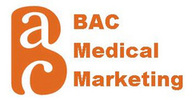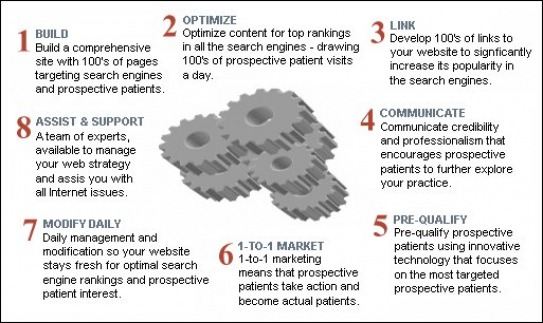Glossary of marketing terms -- Workflow process -- Featured clients
How we work

We Create an Effective Marketing Strategy!
Creating an effective marketing strategy can be quite easy, and it doesn't have to cost you a fortune. Please consider the following:
> New-Patient Handouts - You should give each new patient literature describing your practice and its mission.
If a patient has written you a note thanking you for your especially compassionate care, ask if you can share a part of that note with other patients.
The idea is to convey your message in such a way that your patients believe your sincerity and begin to talk about the practice in the same terms you've used.
Also, match your processes to the image you are projecting. If you want to establish yourself as technologically advanced in your patients' minds, ask them to complete office forms on tablet PCs or at a check-in kiosk. Shape your patients' experiences so they conform to your branding strategy.
> In-Office Images – These include the artwork and any photographs or diagrams on your walls.
Rather than leaving up that old chart describing contraceptive options or showing a cross-section of the inner ear, use your walls to make a statement about your practice. Frame and hang patient testimonials within view of your visitors.
> Timely Follow-Up – Consider sending new patients a handwritten note, thanking them for their visit, or find another way to follow up that is consistent with your brand promises.
> Printed Marketing Materials – Review your current brochures, ads, and any other marketing collateral, with your new marketing strategy in mind.
Once you've revamped your internal image, you may want to consider some external outreach, such as direct mail and advertising. This is what comes to mind when most people think of marketing.
The key here is to use your dollars wisely by tracking your results. We worked with one physician in Southern California who advertised heavily but didn't really know whether his strategy was attracting new business. He just threw stuff out there and figured overall it was bringing in business and paying for itself. Armed, at last, with return-on-investment data, the physician was able to slash his ad budget by a third without seeing any decline in patient response. He just stopped doing what wasn't working.
The best time to capture accurate information regarding where new patients found out about your practice is when they first call in to make an appointment. That's when the information is on the top of their minds. You're less likely to get an accurate response once patients arrive in your office and get handed reams of paperwork. At that point, it's all too easy for them to ignore the little line that asks where they heard about the practice.
Instruct your scheduler to simply ask new patients, "Whom can we thank for referring you to us today?" The patient will either answer with a name or acknowledge using some other channel to locate you. Most practices don't ask, so they are flying blind.
Or you may want to try one of the newer services that allow you to create a phone number specific to each of your direct-mail or advertising campaigns. Such services assign unique phone numbers to different ads. When patients call, that number is directed to your front desk. A report generated by the service allows you to track how many calls different ads generated without having to involve your office staff.
Bottom Line: Know how your marketing dollars are - or are not - working for you. Whether your marketing strategies are quiet or loud, you can use the tools of the trade to enhance your patient base without feeling like a used-car salesman.




